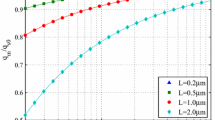Usually one wants to measure the thermal radiance emitted by a hot-surface at a wavelength as short as possible, since the uncertainty in the true temperature due to unknown emissivity decreases with decreasing wavelength. Unfortunately the radiance also decreases with decreasing wavelength, and hence the signal-to-noise ratio becomes worse with shorter wavelengths. Depending on what temperature range is to be covered, a reasonable compromise can be found for most applications. When pyrometry is applied to shock physics experiments, there is an additional factor that has to be taken into consideration. Due to the nature of shock physics experiments, one has to deal with background light caused by flashes from air lighting up, high-explosive light, and muzzle flash from a powder gun, etc. In addition, even if the experiment is designed appropriately, there is often a temperature non-uniformity as well as thermal radiation from transparent anvils that are used to increase the interface pressure. In most cases, there is no engineering approach to minimize these temperature non-uniformities. The sensitivity to these non-uniformities increases with decreasing wavelength for the very same reason that the sensitivity to uncertainties in emissivity is increasing. This paper describes the above problems, deals with the problem of temperature non-uniformity in detail, and presents arguments why single-wavelength pyrometry in shock physics experiments can be very deceiving even in well designed experiments.
Similar content being viewed by others
References
Seifter A., Boboridis K., Obst A.W. (2004). Int. J. Thermophys. 25:547
Zhou Y.H., Zhang Z.M. (2003). J. Heat Transfer 125:462
“Standard Test Method for Noise Equivalent Temperature Difference of Thermal Imaging Systems,” ASTM Standard E 154313-94 (1994).
D. P. DeWitt and G. D. Nutter, Theory and Practice of Radiation Thermometry (John Wiley & Sons, New York, 1988).
Raikes S.A., Ahrens T.J. (1979). Geophys. J. R. Astron. Soc. 58:717
A. Seifter, M. Grover, D. B. Holtkamp, J. R. Payton, P. Rodriguez, W. D. Turley, and A.W. Obst, “High Speed Photography and Photonics,” SPIE Paper #5580-125, Virginia (2005), pp. 18–23.
G. Neuer and L. Fissler, “Crytical Analysis of the Different Methods of Multiwavelength Pyrometry,” in Temperature: Its Measurement and Control in Science and Industry, Vol. 6, J. F. Schooley, ed. (AIP, New York, 1992), p. 797.
M. Born and R. Wolf, Principles of Optics, 7th Ed. (Cambridge University Press, 1999).
K. Boboridis, A. Seifter, A. W. Obst, and D. Basak, Int. J. Thermophys. 25:1187 (2004).
Barker L.M., Hollenbach R.E. (1972). J. Appl. Phys. 43:4669
K. Boboridis and A. W. Obst, “A High-Speed Four-Channel Infrared Pyrometer,” in Temperature: Its Measurement and Control in Science and Industry, Vol. 7, Part 2, D. C. Ripple, ed. (AIP, New York, 2003), p. 759.
Seifter A., Sachsenhofer F., Pottlacher G. (2002). Int. J. Thermophys. 23:1267
Author information
Authors and Affiliations
Corresponding author
Rights and permissions
About this article
Cite this article
Seifter, A., Obst, A.W. About the Proper Wavelength for Pyrometry on Shock Physics Experiments. Int J Thermophys 28, 934–946 (2007). https://doi.org/10.1007/s10765-007-0191-1
Published:
Issue Date:
DOI: https://doi.org/10.1007/s10765-007-0191-1




